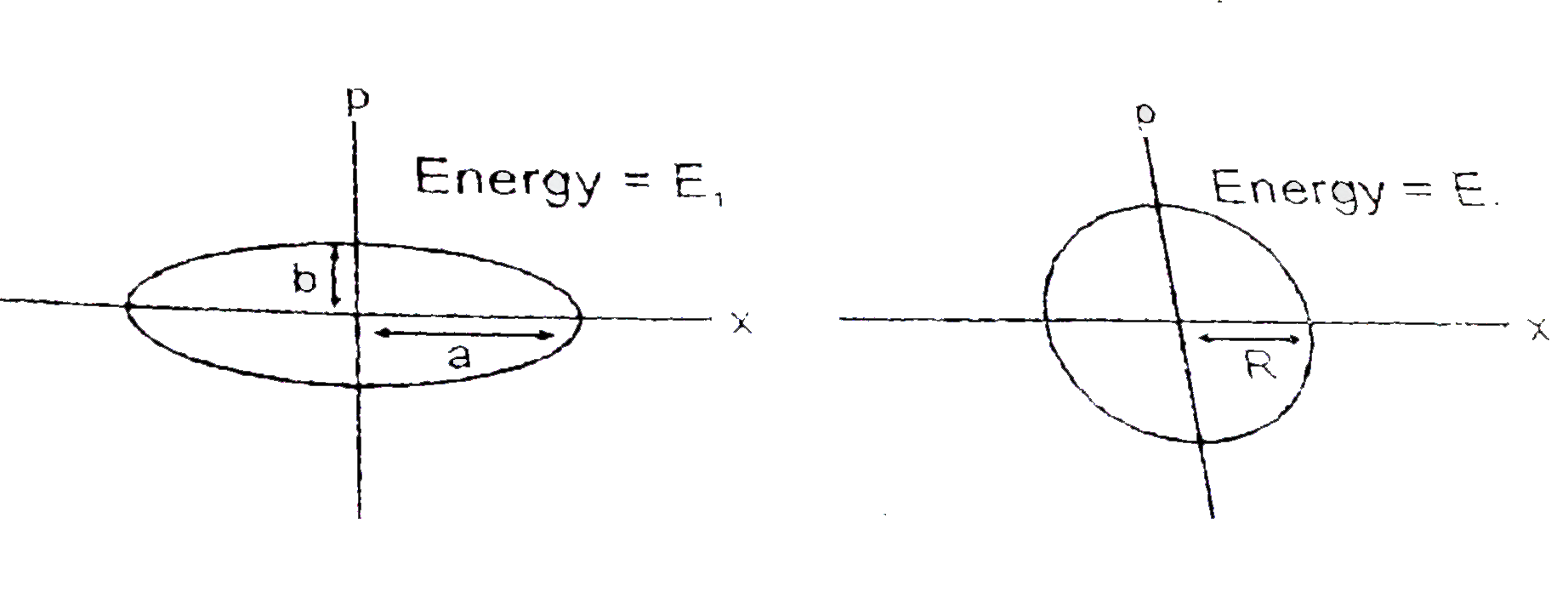Two independent harmonic oscillators of equal mass are oscillating about the origin with angular frequencies (omega_1) and (omega_2) and have total energies (E_1 and E_2), respectively. The variations of their momenta (p) with positions (x) are shown (s) is (are).

E1ω1=E2ω2
ω2ω1−n2
ω1ω2=n2
E1ω1=E2ω2
The correct Answer is:B, D
For forst oscillator E1=12mω21a2, and p=mv=mω1a=b⇒ab=1mω1…….(i)
for second oscillator
E2=12mω22R2, and mω2=1………….(ii)
(ab)=ω2ω1=n2
E1ω21a2=E2ω22R2⇒E1ω1=E2ω2
Topper's Solved these Questions
- BOOK - NARAYNACHAPTER - OSCILLATIONSEXERCISE - ASSERTION & REASON QUESTIONS13videos
OSCILLATIONS
- BOOK - NARAYNACHAPTER - OSCILLATIONSEXERCISE - LEVEL-V1videos
OSCILLATIONS
- BOOK - NARAYNACHAPTER - OSCILLATIONSEXERCISE - NCERT BASED QUESTIONS1videos
OSCILLATIONS
- BOOK - NARAYNACHAPTER - NEWTONS LAWS OF MOTIONEXERCISE - PASSAGE TYPE QUESTION6videos
NEWTONS LAWS OF MOTION
- BOOK - NARAYNACHAPTER - PHYSICAL WORLDEXERCISE - C.U.Q10videos
PHYSICAL WORLD
Similar Questions
Two bodies of masses m1 and m2 have equal kinetic energies. What is the ratio of their linear momenta?
View SolutionTwo physical pendulums perform small oscillations about the same horizontal axis with frequencies ω1 and ω2 . Their moments of inertia relative to the given axis are equal to I1 and I2 respectively. In a state of stable equilibium the pendulums were fastened rigifly together. What will be the frequency of small oscillations of the compound pendulum ?
View Solution
Knowledge Check
- Question 1 - Select One or More
Two independent harmonic oscillators of equal mass are oscillating about the origin with angular frequencies ω1 and ω2 and have total energies E1 and E2 repsectively. The variations of their momenta p with positions x are shown in figures. If ab=n2 and aR=n, then the correc t equation(s) is (are) :
 AE1ω1=E2ω2Bω2ω1=n2Cω1ω2=n2DE1ω1=E2ω2
AE1ω1=E2ω2Bω2ω1=n2Cω1ω2=n2DE1ω1=E2ω2 - Question 2 - Select One
Two bodies of different masses m1 and m2 have equal momenta. Their kinetic energies E1 and E2 are in the ratio
A√m1:√m2Bm1:m2Cm2:m1Dm21:m22 - Question 3 - Select One
For a linear harmonic oscillator, its potential energy, kinetic energy and total energy given by EP,KKandET respectively. Its maximum acceleration is given by
A√2EPmB√2EKmC√2ETmAD2ETmA
The forced harmonic oscillations have equal displacement amplitude at frequencies ω1=400s−1 and ω2=600s−1. Find the resonance frequency at which the displacement amplitude is maximum.
View SolutionTwo discs A and B are in contact and rotating with angular velocity with angular velocities ω1andω2 respectively as shown. If there is no slipping between the discs, then
 View Solution
View SolutionFind the angular frequency and the amplitude of harmonic oscillations of a particle if at distances x1 and x2 from the equalibrium position its velocity equald v1 and v2 respectively.
View SolutionA mass m oscillates with simple harmonic motion with frequency f=ω2πand amlitude A on a spring with constant K. therefore
View SolutionWhat is the time period of a wave having angular frequency (ω) equal to 0.5s−1?
View Solution

